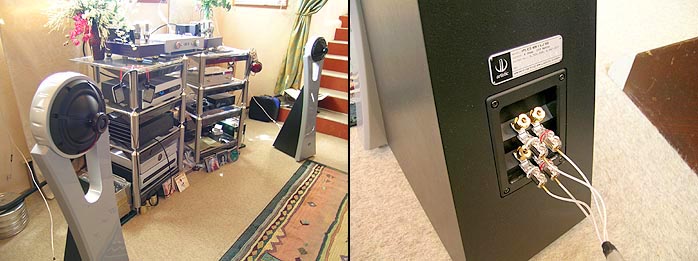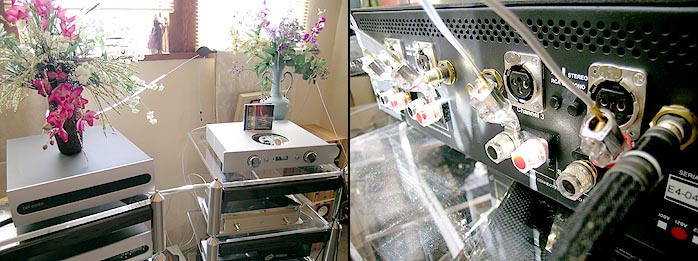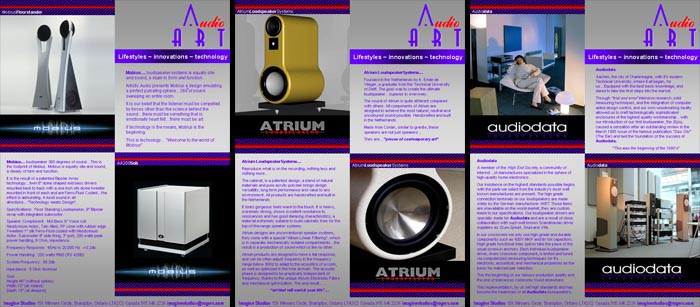 |
||||||||
| Before we get to subjective listening impressions, let's consider John Larson's response to my comments on large-size domes: " I understand your skepticism about the size of the domes. Remember that the main reason why manufacturers did not use larger coils/domes is because large Neodymium rings were not so readily available until just a few years ago. Without Neodymium for the motor assemblies, the magnet structure would have to be huge to create the necessary gauss strength - not very cost effective. Another advent that makes larger voice coils possible is the use of copper-clad aluminum wire which reduces weight by 40%. We also installed a spider which many domes do not use. This keeps the diaphragm linear when moving and prevents yaw, another problem some of the first big domes had. However, these are not the reasons why we chose the 8" size of the dome. We actually wanted to maintain the purist philosophy of a two-way speaker, using a one inch tweeter and an 8" driver. The elimination of phase error is the reason why we decided to mount the tweeters directly in front of the midbass drivers. Additionally, the tweeter acts as a phase plug against any break-up from the tip of the dome. There is a common belief that larger domes tend to beam more than a conventional woofer. We have found that our domes have an almost perfect polar plot when bolted back to back. The drivers couple in a way that prevents beaming. You can test this for yourself by walking around the speaker during your review." |
||||||||
 |
||||||||
My AUDIOPAX monos and Wyetech Labs' potent paralleled 300B Saphhires had more than enough gain to drive the 88dB Möbius to the usual levels without any apparent effort. Still, I was bothered by several shortcomings that clearly afflicted the presentation. This held true even when I removed the thick plasticized metal grill cups: A lack of dynamics, transparency, attack and speed. It sounded as though the power response of the midrange drivers far - er, overpowered that of the tweeters. Things sounded a bit murky, indistinct, dark/warm and overly polite. Another way of saying the same thing would be to cite the trite and obvious: 8" two-way speaker, the kind whose midrange driver seems too ponderous and indistinct to mate well with a fast and open 1" tweeter. It makes a 4" or at the most 5.5" driver preferable to the 8-incher. Or at least so a would-be arm-chair speaker designer might assume. Inserting my less expensive Gallo Reference 3s instantly transformed the entire presentation from uninvolving and boring to exciting and thoroughly convincing. Life, energy and sparkle returned, resolution increased and bass reach and precision relegated the Möbius' side-firing eight-incher to runner-up. |
||||||||
 |
||||||||
In toto, I was suffering all the tell-tale punishments of amplifiers which, despite sufficient gain, just could not deliver the necessary current and damping factor to get a more demanding speaker load out of first gear. Time to park the tube amps on the side lines and roll out the serious muscle. Bel Canto's eVo4 Gen.II Tripath Digital Power Processing in 360wpc bridged-balanced mode to the rescue. |
||||||||
 |
||||||||
Ah - redemption time. Now I was beginning to hear what the Möbius was most likely all about. By design, bipolars don't image as sharply as direct radiators. That's why Canada's Mirage splits the front/back radiation balance of certain of their models 70/30 to create a precedence effect for the direct signal over the rear-firing 'ambient field' portion. However, the Möbius does not attenuate its rear energy. With the wrong amplifier, you combine an inherently more diffuse sound field with transients that are additionally softened by insufficient current delivery to take control of those monster 6-inch voice coils. The end result? Exasperation of that particular soft mien of omnis. That said, even with 360 watts behind it, the Möbius still wanted to see higher input voltages to really wake up. It's somewhat compromised for late-night listening or apartment dwellers forced to tolerate permanent low volumes as a consideration of their neighbors. Because the Möbius' ported bass isn't as articulate and weighty as that of the sealed-alignment Gallo Acoustics Reference 3 to begin with, it starts to prematurely attenuate and erode when you reduce playback levels to below its 'optimized torque transfer' window. That leans out the presentation and injects a certain amount of bleaching. This white-wash effect disappears once the Möbius enters its power zone. That isn't unrealistically high but certainly well above background levels. |
||||||||
 |
||||||||
What the Möbius presents is a most excellent portrayal of the depth dimension and a complete absence of image drift. This laid-back but solid perspective is coupled to a far wider-than-usual sweet spot and soft-focus lead vocals that don't lock into place as precisely as mono-polar designs create and thus might take some getting used to for appearing a little bigger yet less concrete than you'd expect. While clearly grateful for high-current power delivery, the Möbius in my setup remained more of a classic Vandersteen 2ce than modern high-resolution design when it came to capturing the most subtle details buried in the soundstage. However, it clearly lacked the Vandy's fulsome prowess below 50Hz which would have added sock'em drive and fleshiness. Running through a gamut of programme material, I concluded that playing speaker designer for a moment, I'd experiment with a second woofer per Möbius, mounting it opposite the existing one to increase air-moving surface and displacement in accord with the doubled-up mid/treble band which currently seems disproportionally leading - at least in a sizable space like mine. This twin-woofer array would also raise bass system sensitivity by 3dB for more output. As is it, the speaker wants for power down low. The Möbius is also not the most dynamic of speakers. It lacks the kind of jump factor this listener has come to expect from being exposed to not only horns but also the minimum-crossover Gallo Reference design. What becomes somewhat of a micro-dynamic reticence by comparison tends to be a byproduct of speakers which require lots of power to get going. Even once in motion, they still paint with a broader brush and will never exhibit the lightning-fast reflexes and acute detail of horns or 'stats. Naturally, not everyone favors such a lively, agile and 'fast' sound. However, in order to better balance the existing Möbius, one would require more displacement in the bass region -- or add a good subwoofer -- to properly anchor the current midrange focus. I now found myself at a common conundrum which, sooner or later, faces every reviewer. I was dealing with a speaker whose tonal voicing and overall presentation didn't gel with what I'm personally looking for. I would have to envision what kind of listener might fancy it over 'my' sound. First off, the Möbius casts a very big stage. What it gives up in ultimate resolution it makes up for in size. Let's face it, not everyone is enamored with the whole sweet-spot notion of stationary one-person listening. If you're someone who wants to enjoy music over a broad range of locations -- sitting, standing, moving about -- the Möbius fills that bill perfectly. Not unlike the clever tag line 'Whole-Room Stereo" which is owned by Ohm Acoustics, the Artistic Audio aesthetic could underwrite the same ad campaign. |
||||||||
 |
||||||||
Secondly, if you favor the midrange-centric sound of old-fashioned triodes with a slightly rolled-off top end, somewhat curtailed reach down low and an emphasis on warmth and softness over incisiveness and dynamic wallop, the Möbius delivers without a single valve in sight. Think push/pull pentodes for scale and size, single-ended direct-heated triodes for tonal and transient qualities. Now add a very modern 'non-speaker' look that makes its grill part of the design statement. You could conclude that Artistic Audio's target audience is less the Stereophile-devouring audiophile and more the decor-conscious regular person who doesn't expect a photo-realistic recreation of the music but a wall-of-sound type experience. Now the only question really becomes whether that kind of customer reads 6moons. While I could have set out on a detailed quest to report on what I heard, my personal bend of notions infected with the audiophile virus makes me probably the wrong person for today's task. Unlike the Gallo Reference 3 review which I actively pursued in response to two prior and personal trade show experiences, today's assignment was the outcome of Morrie Serber from Imagine Studio [promo sheet above] becoming the go-between. He represents the product and saw a publicity opportunity with 6moons. Relying on personal recommendations from folks you don't know and have never listened together with can backfire. Many readers already know this who have bought product based on reviews only to find something other than expected. I also remain suspicious that twin 8-inch mids coupled to another 8-inch woofer isn't the most copasetic of matches. In fact, I was surprised by John Larson's stated ideal of the 8" 2-way. When I am thinking two-ways, I'm thinking Platinum Solo, Sonus Faber Concerto, Soliloquy Model 5.0 territory - 4.5" to 6" two-ways. Consider this just further evidence that reviewer and review subject were improperly matched in this instance. One item that had less to do with personal taste? The soft plastic stems holding the tweeters in place came loose on multiple occasions, mandating reattachment to their transducers which otherwise would have hovered uncentered on one or two supports instead of four. This was simple enough to fix but not acceptable in any product selling for more than a few hundred dollars and certainly not in one at $3,500. This particular issue could perhaps be resolved with a positive snap-lock fitting? |
||||||||
| In the final analysis, Artistic Audio's concept of the spherical dynamic transducer strikes me as presently looking more appealing on paper still than it actually sounds in execution - and I don't believe my ancillary equipment or room were to blame for my reactions. From where I sit, the jury's thus still out on what the Möbius might morph into with further development of the spherical driver array. The thing is, an 'ordinary Joe' -- and I say this with no judgment whatsoever but merely to distinguish such a non-predisposed customer from the agonized, hyper-critical neurotic audiophile we enjoy making fun of -- would probably love the Möbius for the exact reasons I didn't. While it's boiler-plate stuff, this product in particular warrants the usual reminder: Tastes differ and you gotta make up your own mind. There's far too much going on here to overlook what the Möbius attempts to address. | ||||||||
 |
||||||||
| Artistic Audio responds: The tone of this article leads me to believe the reviewer's tastes are that of high-efficiency, forward-staging reproduction. I have a few accounts that are in this group of followers that would not think about using a driver larger than 6-inch diameter. Imaging is locked with this type of design due to small baffle area and driver size. Low power input is typical especially with low-order crossover designs. Compression horn systems that Srajan likes are very efficient, but usually lack the flat frequency response capable of a dome-type system and have very low power handling capability. This said, I find this review to be totally subjective to personal taste and equipment preference. Without the use of any test equipment, the results are limited to the personal taste, sonic ability of the electronics and software in use. The Möbius system can deliver a large open life-like soundstage in 2-channel, theater or multi-channel audio configurations, making it a very good balance for today's buyer. The large open stage can be contributed to the size of the dome midbass driver. President, John Larsen Artistic Audio Inc. |
||||||||
 |
||||||||
 |
||||||||
|
Manufacturer's website
|
||||||||
 |
||||||||